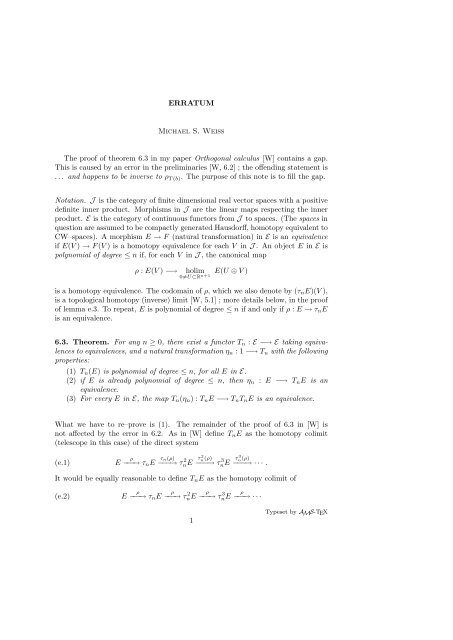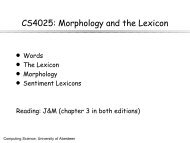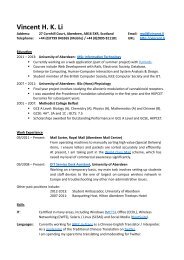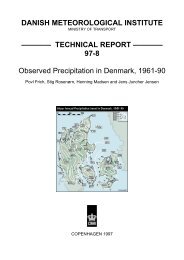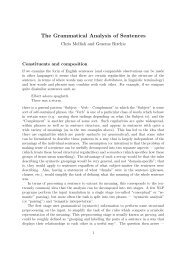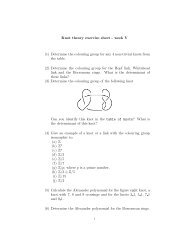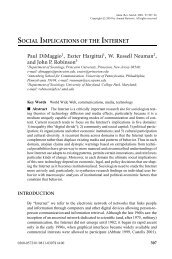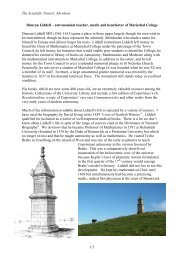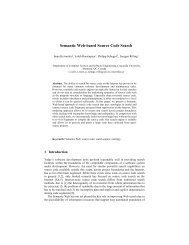ERRATUM Michael S. Weiss The proof of theorem 6.3 ... - Homepages
ERRATUM Michael S. Weiss The proof of theorem 6.3 ... - Homepages
ERRATUM Michael S. Weiss The proof of theorem 6.3 ... - Homepages
You also want an ePaper? Increase the reach of your titles
YUMPU automatically turns print PDFs into web optimized ePapers that Google loves.
<strong>ERRATUM</strong><br />
<strong>Michael</strong> S. <strong>Weiss</strong><br />
<strong>The</strong> <strong>pro<strong>of</strong></strong> <strong>of</strong> <strong>theorem</strong> <strong>6.3</strong> in my paper Orthogonal calculus [W] contains a gap.<br />
This is caused by an error in the preliminaries [W, 6.2] ; the <strong>of</strong>fending statement is<br />
. . . and happens to be inverse to ρ T (b). <strong>The</strong> purpose <strong>of</strong> this note is to fill the gap.<br />
Notation. J is the category <strong>of</strong> finite dimensional real vector spaces with a positive<br />
definite inner product. Morphisms in J are the linear maps respecting the inner<br />
product. E is the category <strong>of</strong> continuous functors from J to spaces. (<strong>The</strong> spaces in<br />
question are assumed to be compactly generated Hausdorff, homotopy equivalent to<br />
CW–spaces). A morphism E → F (natural transformation) in E is an equivalence<br />
if E(V ) → F (V ) is a homotopy equivalence for each V in J . An object E in E is<br />
polynomial <strong>of</strong> degree ≤ n if, for each V in J , the canonical map<br />
ρ : E(V ) −→ holim<br />
0�=U⊂Rn+1 E(U ⊕ V )<br />
is a homotopy equivalence. <strong>The</strong> codomain <strong>of</strong> ρ, which we also denote by (τnE)(V ),<br />
is a topological homotopy (inverse) limit [W, 5.1] ; more details below, in the <strong>pro<strong>of</strong></strong><br />
<strong>of</strong> lemma e.3. To repeat, E is polynomial <strong>of</strong> degree ≤ n if and only if ρ : E → τnE<br />
is an equivalence.<br />
<strong>6.3</strong>. <strong>The</strong>orem. For any n ≥ 0, there exist a functor Tn : E −→ E taking equivalences<br />
to equivalences, and a natural transformation ηn : 1 −→ Tn with the following<br />
properties:<br />
(1) Tn(E) is polynomial <strong>of</strong> degree ≤ n, for all E in E.<br />
(2) if E is already polynomial <strong>of</strong> degree ≤ n, then ηn : E −→ TnE is an<br />
equivalence.<br />
(3) For every E in E, the map Tn(ηn) : TnE −→ TnTnE is an equivalence.<br />
What we have to re–prove is (1). <strong>The</strong> remainder <strong>of</strong> the <strong>pro<strong>of</strong></strong> <strong>of</strong> <strong>6.3</strong> in [W] is<br />
not affected by the error in 6.2. As in [W] define TnE as the homotopy colimit<br />
(telescope in this case) <strong>of</strong> the direct system<br />
(e.1) E ρ<br />
−−−→ τnE τn(ρ)<br />
−−−→ τ 2 nE<br />
τ 2<br />
n (ρ)<br />
−−−→ τ 3 nE<br />
τ 3<br />
n (ρ)<br />
−−−→ · · · .<br />
It would be equally reasonable to define TnE as the homotopy colimit <strong>of</strong><br />
(e.2) E ρ<br />
−−−→ τnE ρ<br />
−−−→ τ 2 nE<br />
1<br />
ρ<br />
−−−→ τ 3 nE<br />
ρ<br />
−−−→ · · ·<br />
Typeset by AMS-TEX
2 MICHAEL S. WEISS<br />
where the k–th map in the direct system is ρ : τ k−1<br />
n<br />
E −→ τn(τ k−1<br />
n E). It turns out<br />
that the homotopy colimits <strong>of</strong> (e.1) and (e.2) are isomorphic, even relative to E.<br />
Namely, the Fubini principle for homotopy limits gives<br />
(τ k nE)(V ) ∼ = holim<br />
0�=U1,...,Uk⊂R n+1 E(U1 ⊕ · · · ⊕ Uk ⊕ V ) .<br />
Using this as an identification and inspecting the maps in the direct systems (e.1)<br />
and (e.2), one finds that the direct systems are isomorphic.<br />
e.3. Lemma. Let p : G → F be a morphism in E. Suppose that there exists an<br />
integer b such that p : G(W ) → F (W ) is ((n + 1) dim(W ) − b)–connected for all W<br />
in J . <strong>The</strong>n τn(p) : τnG(W ) → τnF (W ) is ((n + 1) dim(W ) − b + 1)–connected for<br />
all W .<br />
Pro<strong>of</strong>. We begin with a discussion <strong>of</strong> the homotopy limits involved. Suppose first<br />
that Z is any functor from the poset D <strong>of</strong> nonzero linear subspaces <strong>of</strong> R n+1 to<br />
spaces. Ignoring the topology on D, we can define holim Z as the totalization <strong>of</strong><br />
the incomplete cosimplicial space<br />
(e.4) [k] ↦→ �<br />
L:[k]↩→D<br />
Z(L(k))<br />
where L runs over the order–preserving injections from the poset [k] = {1, . . . , k}<br />
to D. (An incomplete cosimplicial space is a covariant functor from the category<br />
with objects [k] for k ≥ 0 and monotone injections as morphisms to the category<br />
<strong>of</strong> spaces ; the totalization <strong>of</strong> such a thing is the space <strong>of</strong> natural transformations<br />
to it from the functor [k] ↦→ ∆k .)<br />
We could make (e.4) into a complete cosimplicial space by dropping the injectivity<br />
condition on the order–preserving maps L ; the totalization would not change.<br />
However, totalizations <strong>of</strong> incomplete cosimplicial spaces are usually easier to understand<br />
than totalizations <strong>of</strong> complete cosimplicial spaces.— In (e.4), it is understood<br />
that a product �<br />
i∈S<br />
with empty S is a single point ∗ ; therefore the right–hand<br />
side <strong>of</strong> (e.4) is a point for k > n + 1.<br />
Remembering the topology on D now, we note that D is a union <strong>of</strong> Grassmannians.<br />
Let us suppose that the spaces Z(U) are the fibers <strong>of</strong> a fiber bundle ξ on<br />
D (that is, Z(U) is the fiber over U ∈ D), and that maps Z(U1) → Z(U2) induced<br />
by inclusions U1 ⊂ U2 depend continuously on U1, U2. <strong>The</strong>n it is appropriate to<br />
replace the incomplete cosimplicial space (e.4) by another incomplete cosimplicial<br />
space,<br />
(e.5) [k] ↦→ Γ(e ∗ kξ)<br />
where ek is the evaluation map L ↦→ L(k), with domain equal to the space <strong>of</strong><br />
monotone injections L : [k] → D, and codomain D. <strong>The</strong> symbol Γ denotes a section<br />
space. <strong>The</strong> totalization <strong>of</strong> (e.5) is the topological homotopy limit <strong>of</strong> Z. For us,<br />
the relevant examples are Z(U) := G(U ⊕ W ) and Z(U) := F (U ⊕ W ) where W is<br />
fixed ; the topological homotopy limits are then τnG(W ) and τnF (W ), respectively.
<strong>ERRATUM</strong> 3<br />
<strong>The</strong> space <strong>of</strong> monotone injections [k] → D is a disjoint union <strong>of</strong> manifolds C(λ).<br />
Here λ : [k] → [n + 1] is a monotone injection avoiding the element 0 ∈ [n + 1],<br />
and C(λ) consists <strong>of</strong> those L : [k] → D for which L(i) has dimension λ(i). Writing<br />
λi = λ(i) we find<br />
k−1 �<br />
dim(C(λ)) = (n + 1 − λk)λk + (λi+1 − λi)λi<br />
k−1 �<br />
= (n + 1)λk +<br />
i=0<br />
< (n + 1)λk − k .<br />
i=0<br />
λiλi+1 −<br />
We see from (e.5) that the connectivity <strong>of</strong> τn(p) : τnG(W ) → τnF (W ) is greater<br />
than or equal to the minimum <strong>of</strong> the numbers<br />
(connectivity <strong>of</strong> p : G(L(k) ⊕ W ) → F (L(k) ⊕ W )) − dim(C(λ)) − k<br />
taken over all triples (L, λ, k) with L ∈ C(λ) and λ : [k] → [n+1]. By our hypothesis<br />
on p : G → F , the connectivity <strong>of</strong> p : G(L(k) ⊕ W ) → F (L(k) ⊕ W )) is at least<br />
equal to (n + 1)(λk + dim(W )) − b. By the inequality for dim(C(λ)), the minimum<br />
in question is greater than (n + 1) dim(W ) − b. �<br />
Remark. <strong>The</strong> hypothesis in lemma e.3 is strongly reminiscent <strong>of</strong> what Goodwillie<br />
in his calculus calls agreement to n–th order, in [Go3] and (for n = 1) in [Go1, 1.13].<br />
Goodwillie also has lemmas similar to e.3, such as [Go1, 1.17] and [Go3, 1.6].<br />
We fix some V in J from now on ; the goal is to prove that ρ from TnE(V ) to<br />
τn(TnE)(V ) is a homotopy equivalence for any E in E.<br />
For W in J let mor(V, W ) be the space <strong>of</strong> morphisms V → W in J and let γ1(V, W )<br />
be the Riemannian vector bundle on mor(V, W ) whose total space is the set <strong>of</strong> (f, x)<br />
in mor(V, W ) × W with x ⊥ im(f). Let γn+1(V, W ) be the Whitney sum <strong>of</strong> n + 1<br />
copies <strong>of</strong> γ1(V, W ), and let Sγn+1(V, W ) be the unit sphere bundle <strong>of</strong> γn+1(V, W ).<br />
We abbreviate<br />
F (W ) := mor(V, W )<br />
G(W ) := Sγn+1(V, W )<br />
and write p : G → F for the projection. By [W, 4.2, 5.2] the object G in E co–<br />
represents the functor E ↦→ τnE(V ) from E to spaces. In more detail, writing<br />
nat(. . . ) for spaces <strong>of</strong> natural transformations, we have a commutative diagram,<br />
natural in E:<br />
(e.6)<br />
E(V )<br />
⏐<br />
�∼ =<br />
nat(F, E)<br />
ρ<br />
−−−−→ τnE(V )<br />
⏐<br />
�∼ =<br />
p ∗<br />
−−−−→ nat(G, E) .<br />
k�<br />
i=0<br />
λ 2 i
4 MICHAEL S. WEISS<br />
e.7. Lemma. Tnp : TnG → TnF is an equivalence.<br />
Pro<strong>of</strong>. It is clear that p : G → F satisfies the hypothesis <strong>of</strong> lemma e.3 with b<br />
equal to (n + 1) dim(V ) + 1. (Here V is not a variable ; we fixed it, and used it<br />
in the definition <strong>of</strong> G and F .) Repeated application <strong>of</strong> lemma e.3 shows that the<br />
connectivity <strong>of</strong><br />
τ k n(p) : τ k nG(W ) → τ k nF (W )<br />
tends to infinity as k goes to infinity, for any W in J . <strong>The</strong>refore Tnp is an equivalence.<br />
�<br />
We shall use (e.7) to prove that the commutative square<br />
(e.8)<br />
E(V )<br />
⏐<br />
�ρ τnE(V )<br />
⊂<br />
−−−−→ TnE(V )<br />
⏐<br />
�ρ ⊂<br />
−−−−→ τn(TnE)(V )<br />
can be enlarged to a commutative diagram <strong>of</strong> the form<br />
(e.9)<br />
E(V ) −−−−→ X −−−−→ TnE(V )<br />
⏐<br />
� ρ<br />
⏐<br />
� g<br />
⏐<br />
� ρ<br />
τnE(V ) −−−−→ Y −−−−→ τn(TnE)(V )<br />
in which the map g is a homotopy equivalence. (That is, (e.8) is obtained from (e.9)<br />
by deleting the middle column.) According to (e.6), diagram (e.8) is isomorphic to<br />
(e.10)<br />
nat(F, E)<br />
⏐<br />
�p ∗<br />
nat(G, E)<br />
and clearly (e.10) can be enlarged to<br />
(e.11)<br />
⊂<br />
−−−−→ nat(F, TnE)<br />
⏐<br />
�p ∗<br />
⊂<br />
−−−−→ nat(G, TnE)<br />
nat(F, E) −−−−→ nat(TnF, TnE)<br />
⏐<br />
�p ∗<br />
⏐<br />
�(Tnp) ∗<br />
nat(G, E) −−−−→ nat(TnG, TnE)<br />
res<br />
−−−−→ nat(F, TnE)<br />
⏐<br />
�p ∗<br />
res<br />
−−−−→ nat(G, TnE)<br />
where the arrows labelled res are restriction maps. We are now very close to having<br />
constructed a diagram like (e.9). <strong>The</strong> idea is that since Tnp : TnG → TnF is
<strong>ERRATUM</strong> 5<br />
an equivalence by lemma e.7, the middle arrow in (e.11) ought to be a homotopy<br />
equivalence. Of course, it does not work exactly like that.<br />
What is needed here is the notion <strong>of</strong> c<strong>of</strong>ibrant object in E from the appendix <strong>of</strong><br />
[W]. If v : A → B is an equivalence in E where A and B are c<strong>of</strong>ibrant, then v admits<br />
a homotopy inverse u : B → A, with (natural) homotopies relating vu and uv to<br />
the respective identity maps. Every object in E is the codomain <strong>of</strong> an equivalence<br />
whose domain is a so–called CW–object [W, A.4], and CW–objects are c<strong>of</strong>ibrant<br />
[W, A.3]. More generally, every morphism w : C → D in E has a factorization<br />
C ↩→ D ⋄ −→ D<br />
where D ⋄ −→ D is an equivalence and D ⋄ is a CW–object relative to D. (I leave definition<br />
and <strong>pro<strong>of</strong></strong> to the reader.) This factorization can be constructed functorially<br />
in w : C → D, and if C is already c<strong>of</strong>ibrant, then D ⋄ will be c<strong>of</strong>ibrant.<br />
We apply this with w equal to the inclusion F → TnF or to the inclusion<br />
G → TnG. It follows from (e.6) that F and G are c<strong>of</strong>ibrant. <strong>The</strong>refore (TnF ) ⋄ and<br />
(TnG) ⋄ in the factorizations<br />
F ↩→ (TnF ) ⋄ → TnF , G ↩→ (TnG) ⋄ → TnG<br />
are c<strong>of</strong>ibrant. Replacing TnF and TnG by (TnF ) ⋄ and (TnG) ⋄ in (e.11) we obtain<br />
a commutative diagram<br />
(e.12)<br />
nat(F, E) −−−−→ nat((TnF ) ⋄ , TnE)<br />
⏐<br />
�p ∗<br />
⏐<br />
�<br />
nat(G, E) −−−−→ nat((TnG) ⋄ , TnE)<br />
res<br />
−−−−→ nat(F, TnE)<br />
⏐<br />
�p ∗<br />
res<br />
−−−−→ nat(G, TnE)<br />
and now the middle arrow is a homotopy equivalence. Diagram (e.12) is the explicit<br />
form or fulfillment <strong>of</strong> (e.9).<br />
Pro<strong>of</strong> <strong>of</strong> (1) in <strong>6.3</strong>. We have to show that ρ : TnE(V ) → τn(TnE)(V ) is a homotopy<br />
equivalence. It is enough to show that the vertical arrows in the commutative<br />
diagram<br />
(e.13)<br />
E(V )<br />
⏐<br />
�ρ τnE(V )<br />
ρ<br />
ρ<br />
−−−−→ τnE(V ) −−−−→ τ 2 nE(V ) −−−−→ τ 3 nE(V )<br />
⏐<br />
�ρ ⏐<br />
�ρ ⏐<br />
�ρ τn(ρ)<br />
−−−−→ τ 2 nE(V )<br />
τn(ρ)<br />
−−−−→ τ 3 nE(V )<br />
ρ<br />
τn(ρ)<br />
−−−−→ τ 4 nE(V )<br />
ρ<br />
−−−−→ · · ·<br />
τn(ρ)<br />
−−−−→ · · ·<br />
induce a map between the homotopy colimits <strong>of</strong> the rows which is a homotopy<br />
equivalence. It is enough because τn commutes with homotopy colimits over N up<br />
to homotopy equivalence, and because we can define TnE as the homotopy colimit
6 MICHAEL S. WEISS<br />
<strong>of</strong> (e.2). Denote the homotopy colimits <strong>of</strong> the rows in (e.13) by P and Q, and the<br />
map under investigation by r : P → Q. For each i ≥ 0 the commutative diagram<br />
τ i nE(V )<br />
⏐<br />
�ρ τ i+1<br />
n E(V )<br />
⊂<br />
−−−−→ P<br />
⏐<br />
�r<br />
⊂<br />
−−−−→ Q<br />
can be enlarged, as in (e.9) and (e.12), to a commutative diagram<br />
τ i nE(V ) −−−−→ X −−−−→ P<br />
⏐<br />
� ρ<br />
⏐<br />
�<br />
⏐<br />
�r<br />
τ i+1<br />
n E(V ) −−−−→ Y −−−−→ Q<br />
where the middle vertical arrow is a homotopy equivalence. It follows easily that<br />
r : P → Q is a homotopy equivalence. �<br />
References<br />
[Go1]: T.G. Goodwillie, Calculus I: <strong>The</strong> first derivative <strong>of</strong> pseudoisotopy theory, K-theory 4<br />
(1990), 1–27.<br />
[Go2]: T.G. Goodwillie, Calculus II: Analytic functors, K-theory 5 (1992), 295–332.<br />
[Go3]: T.G. Goodwillie, Calculus III: <strong>The</strong> Taylor series <strong>of</strong> a homotopy functor, Preprint/in<br />
preparation.<br />
[W]: M.<strong>Weiss</strong>, Orthogonal Calculus, Trans. Amer. Math. Soc. 347 (1995), 3743–3796.<br />
Dept. <strong>of</strong> Mathematics, University <strong>of</strong> Notre Dame, Notre Dame, IN 46556, USA<br />
E-mail address: weiss.13@nd.edu


